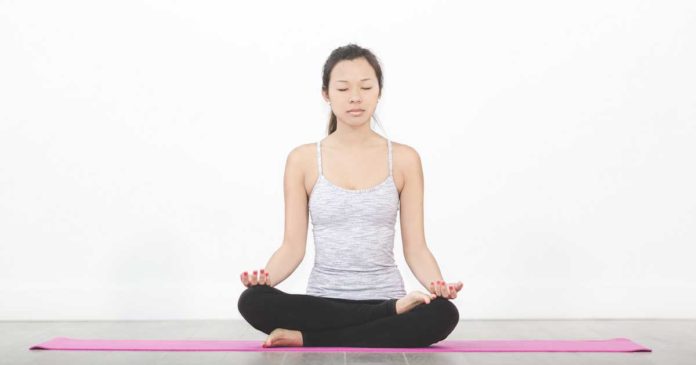Khechari is the transversing of all ethereal regions. Khechari Mudra is the king of all mudras. In layman’s term, it is “the one who moves the sky”.
Are you interested in learning Khechari Mudra? If you are new to yoga and want to learn Khechari Mudra, it is best to start with the basics before attempting to practice it formally.
Khechari Mudra is meant only for advanced yoga practitioners because of certain intricacies it involves. Once mastered, a proficient practitioner can reach a higher state of consciousness and inner peace.
It is one of the yoga practices which was created by ancient masters inspired by imitating snakes. Legend has it that snakes hibernate before going to perform Khechari Mudra.
What made the Khechari Mudra a popular trend ?
What made the Khechari Mudra a popular trend is that, once you have stimulated specific points inside your nasal cavity, precisely behind the uvula, a particular fluid is released. This fluid is believed to possess potential healing powers. The taste of this fluid may vary at first, but when you finally taste this sweet nectar or call “Amrit,” you can provide you with countless benefits.
Khechari Mudra, The Tongue Lock
It is a yoga practice where the usage of the tongue is very important.
To successfully execute this yoga practice, proper and well-trained use of your tongue is extremely necessary. Although you might find it difficult to master certain tongue movements, continuous training will yield a profound state of calmness.
To do this, the tongue will have to be spun up to reach the soft palate first. Through continuous practice and discipline, the language will eventually reach the nasal cavity and fin allay, the uvula. Once this is achieved, it should be followed by a breathing technique used only for this specific mudra. When successfully executed, only then can you reap the benefits of the so-called Khechari Mudra.
Benefits of Practicing Khechari Mudra
Many say that practicing this improved their overall health and they have observed many positive results in doing so.
Some benefits are backed up by facts and testimonials, so we will divide them into two categories, the one I have heard about from many different practitioners and mythical beliefs.
Mythical beliefs associated with Khechari Mudra:
- Can stop the aging process
- Can prevent you from having any disease or illness
- Can help you survive without food or water
- Can make you immune to snake venoms
- Can help achieve nirvana or state of enlightenment
- Immortality
These mythical benefits might be a bit reaching and unrealistic, but it has been part of age-old beliefs passed down through generations. It might not be as true and accurate, but there are real-life benefits that people can attest to.
So, here are some examples of true benefits:
- Can help you in your spiritual growth
- Can increase your lifespan
- Your voice will become attractive and mellow
- Belly fats will greatly be reduced
- Can relax your mind, when practicing this with breathing techniques
- Can energize your body and improve vitality
- Can help with anger management
- Can make you an emotionally healthy person
- Boost the effects of meditation
These benefits are from real people who have tried and tested this yoga practice. The effects and benefits may differ from person to person, depending on the practice’s consistency and accuracy.
Only you can say for sure if all the mentioned benefits are true if you are still willing to try.
Khechari Mudra Steps & Stages:
Now that you are aware of the benefits Khechari Mudra can give you, let’s breakdown the steps on how you can begin with your journey.
Now, you know the benefits of this that can give you, but how will you start?
Here are the steps performing the Khechari Mudra
Let’s start with how you can learn Khechari Mudra
Sit in a comfortable meditation posture, such as Padmasana (Lotus Pose) or Sukhasana (Easy Pose). Ensure that your spine is straight and your body is relaxed.
Close your eyes and take a few deep breaths to relax your mind and body.
Gently touch the tip of your tongue to the roof of your mouth. Initially, it may be challenging to reach the roof of the mouth, so start by placing the tongue as far back as you can comfortably reach.
With regular practice and over time, you can gradually extend the length of your tongue, allowing it to reach further towards the back of the throat. This gradual extension should be done slowly and without force, listening to your body’s natural limits.
As you extend your tongue, you may feel a slight stretching sensation or pressure in the back of your throat. It is important to proceed slowly and mindfully, without causing any discomfort or pain.
Once you have achieved a comfortable extension of the tongue, you can gently move it around and explore the area behind the uvula (the soft tissue hanging down at the back of the throat).
Maintain this position for a few breaths or as long as it feels comfortable. Focus on your breath and the sensations within your mouth and throat.
To release the mudra, slowly and gently bring your tongue back to its natural position, resting on the floor of your mouth.
Stages of performing Khechari Mudra:
Khechari Mudra is an advanced yogic technique that involves the manipulation of the tongue to stimulate specific energy points in the body.
Khechari Mudra: Stage 1 Soft Palate to Uvula.
In Stage 1 of Khechari Mudra, known as Soft Palate to Uvula, the practitioner gently rolls the tip of the tongue back towards the throat until it reaches the soft palate, which is the fleshy part at the back of the roof of the mouth. This action is believed to activate certain energy centers and channels in the head and throat region, enhancing the flow of energy and promoting deep states of meditation. It is important to practice under the guidance of an experienced teacher, as this technique requires proper instruction and caution to avoid any discomfort or injury.
Khechari Mudra: Stage 2 Passing The Uvula.
In Stage 2 of Khechari Mudra, known as Passing the Uvula, the practitioner continues from Stage 1 by extending the rolled-back tongue further back into the throat, attempting to touch or pass the uvula, which is the small, fleshy structure hanging down at the back of the throat. This action is believed to stimulate the upper energy centers and channels in the head, promoting heightened states of consciousness and spiritual development. It is important to approach this technique with caution and under the guidance of an experienced teacher, as it requires proper instruction and practice to avoid discomfort or injury.
Khechari Mudra: Stage 3 Slipping Into The Nasopharynx.
In Stage 3 of Khechari Mudra, known as Slipping into the Nasopharynx, the practitioner continues from Stage 2 by gently pushing the rolled-back tongue further up into the nasal cavity, aiming to reach the nasopharynx, which is the upper part of the throat behind the nose. This action is believed to activate the highest energy centers in the head, leading to profound spiritual experiences and awakening. It is important to note that Stage 3 of Khechari Mudra is extremely advanced and should only be practiced under the guidance of a highly experienced teacher, as it requires extensive preparation and caution to avoid any discomfort or injury.
Khechari Mudra: Stage 4 Pressing Pituitary to Secrete Nectar.
In Stage 4 of Khechari Mudra, known as Pressing Pituitary to Secrete Nectar, the practitioner continues the practice from Stage 3 by gently pressing the back of the tongue against the area of the pituitary gland, which is believed to be located in the center of the brain. This action is thought to stimulate the pituitary gland and trigger the secretion of a substance known as “amrita” or “nectar,” which symbolizes divine bliss and spiritual rejuvenation.
It is important to note that Stage 4 of Khechari Mudra is considered highly advanced and should only be practiced under the guidance of a knowledgeable teacher. The practice requires extensive preparation and caution to avoid any discomfort or injury. Furthermore, the concept of nectar secretion should be understood symbolically rather than as a literal physiological process. The experience of nectar is often described as a metaphorical representation of deep spiritual states and is not to be understood as a physical secretion.
Before practicing Khechari Mudra, it is important to consider the following tips and points:
Seek guidance from a qualified teacher: Khechari Mudra is an advanced yogic practice that requires proper guidance and instruction. It is advisable to learn from an experienced teacher who can provide proper guidance and ensure your safety.
Understand the preparatory practices: Khechari Mudra requires certain preparatory practices, such as tongue stretching exercises and throat opening techniques. Familiarize yourself with these practices and ensure that you have mastered them before attempting the actual mudra.
Be patient and gradual: Khechari Mudra is a gradual process that takes time and patience. Do not rush into advanced stages without properly mastering the earlier ones. Respect your body’s limitations and progress mindfully.
Practice under suitable conditions: Find a calm and quiet space for your practice where you can remain undisturbed. It is best to practice early in the morning on an empty stomach for optimal results.
Listen to your body: Pay attention to any discomfort or pain during the practice. If you experience any pain or strain in the throat or tongue, release the mudra and consult with your teacher.
Practice regularly: Consistency is key in achieving progress with Khechari Mudra. Regular practice, combined with patience and dedication, can lead to gradual improvement in the technique.
Respect individual differences: Every individual is unique, and not everyone may be able to achieve the same level of mastery in Khechari Mudra. Do not compare yourself to others and focus on your own practice and progress.
Conclusion
It is essential to understand that yoga practices are not just a simple trend that one joins because of the bandwagon or hype that it is receiving. In general, yoga is a way of life created to achieve a more peaceful and healthier lifestyle.
Kechari Mudra might be a controversial yoga practice because of the conflicting views and opinions that it’s been receiving. Some claim that this practice is a complete waste of time, while some swear by its power and healing benefits.
It is up to you if you want to try the Khechari Mudra yoga or not and gain benefits.
Only by trying can you say for sure if it helps with your daily life.
But remember, you must first seek help from professionals before trying anything new.









